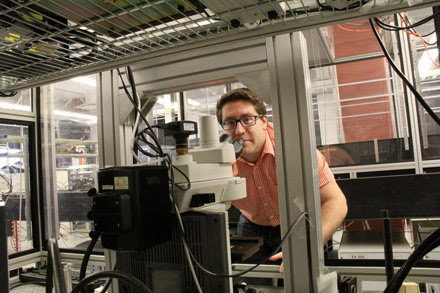An experimental method involving ultrashort laser pulses has been used to connect neurons in vitro. The technique holds promise for the repair of severed nerves.
Researchers from the University of Alberta used a femtosecond laser to bond a neuronal axon and a neuronal soma. Neurons are nervous system cells responsible for transferring information between the brain and the rest of the body.

Nir Katchinskiy and other electrical engineering researchers from the University of Alberta used a femtosecond laser system to “weld” neurons. Courtesy of UAlberta Engineering.
To conduct the study, two neurons were prepared in a solution that prevented them from sticking together. The neurons were brought into contact with each other, and femtosecond laser pulses — occurring every 10 to 15 seconds — were delivered to the meeting point of the two cells.
Although the outside layer of the cells was partially compromised, the inside of that protective layer remained intact. As a result, the two cells established solid bonds forming a common membrane at the targeted area.
Throughout multiple experiments, the cells remained viable and the connection strong. It took the neurons 15 ms to stick to each other; the process would have taken hours to occur naturally, the researchers said.
An important advantage of the method is that it gave researchers complete control on the cell connection process. While the technique is not yet viable for in vivo application, the researchers said it’s an important step towards neuronal repair. So far, the team has applied this method to three types of cells.
"The immediate application is for researchers. They finally have a new tool to do what they have not been able to do before," said Nir Katchinskiy, an electrical engineering Ph.D. student. "We're engineers. We come up with tools that provide potential."
The researchers said femtosecond lasers could prove efficient in prostate, brain and ocular cancer research and treatment. Another possible application is in post-cancer-surgery treatment.
The research was published in Nature Scientific Reports (doi: 10.1038/srep20529).